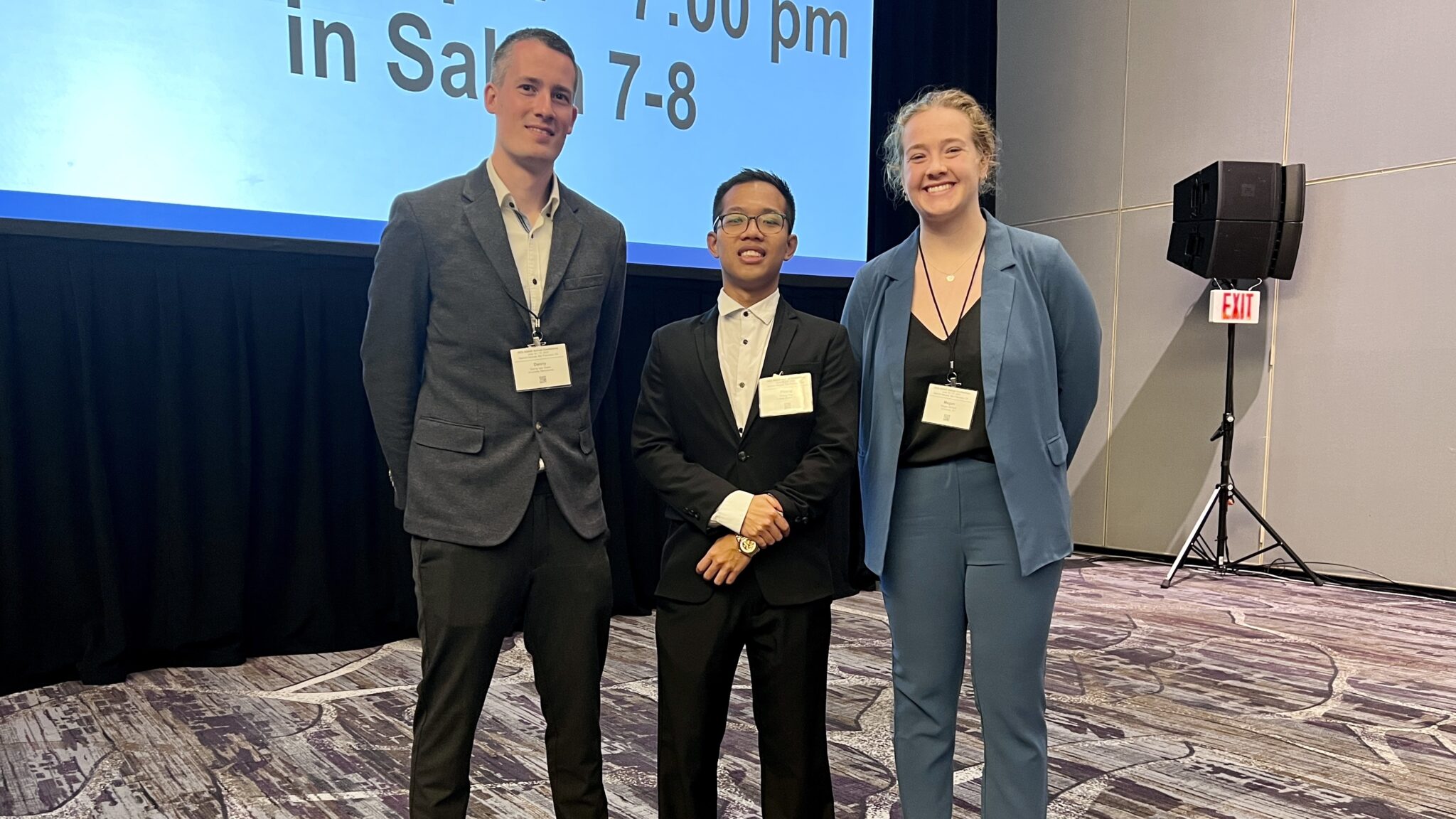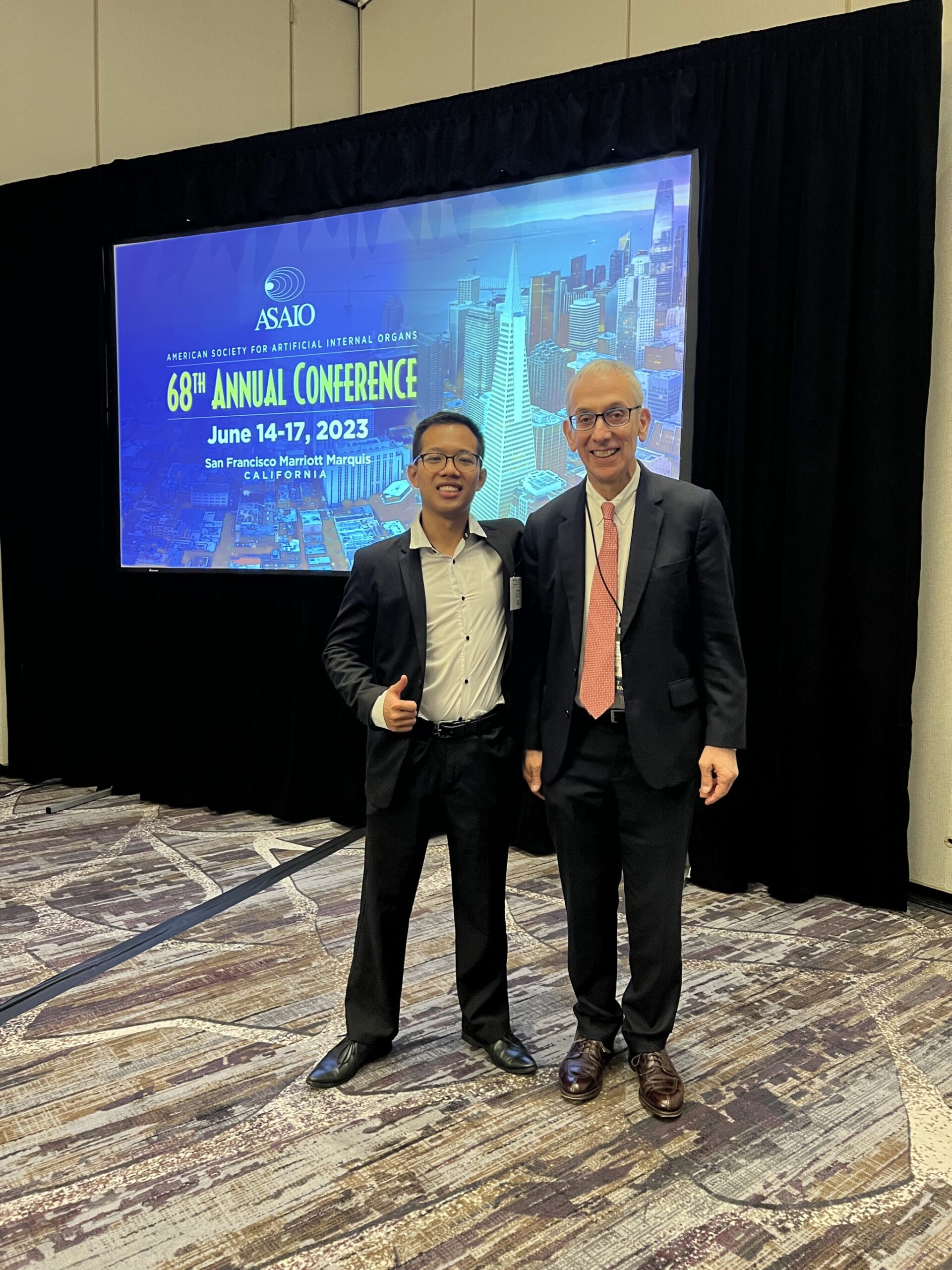Student Scholar Phong Tran Named ASAIO Student Design Competition Finalist

Society Recognizes IDEA Lab Student Scholars Two Years in a Row
Phong Tran, a student scholar in The Texas Heart Institute’s Innovative Device & Engineering Applications (IDEA) Lab and a recent graduate of Texas A&M University, won second place in the ASAIOfyi (for young innovators) Student Design Competition. He was named one of three finalists, along with other undergraduate engineering students from The Ohio State University and the University of Twente, in Enschede, The Netherlands.
Tran was recognized for his project “Interaction Between Fontan Assist Device and Personalized Fontan Circulation Model” and presented his research at the American Society for Artificial Internal Organs 68th Annual Conference (ASAIO 2023) held June 14-17, 2023, in San Francisco.
The ASAIO is a professional society of scientists, engineers, and physicians striving to “save lives one medical device at a time” by providing innovative technological solutions to treat patients with kidney, heart, lung, liver, pancreatic, or nervous system diseases. The ASAIOfyi program advances the work of early-career investigators in the field of artificial organ technologies, with an emphasis on the scientific guidance of undergraduate and graduate students, postdoctoral fellows, and young investigators.
The biomedical engineering team in The Institute’s IDEA Lab, led by Yaxin Wang, PhD, and O.H. Frazier, MD, is focused on developing and evaluating cutting-edge cardiovascular medical devices, including mechanical circulatory support pumps for patients with heart failure and other heart conditions. Student engagement is strongly encouraged: as an ASAIOfyi finalist, Tran joins former student scholar and Texas A&M University alumnus Preston Peak, who won the competition in 2022 and is now a full-time research engineer in the IDEA Lab.
IDEA Lab investigators recognize the power of collaborative science and have formed extensive partnerships with researchers across The Texas Medical Center and around the world. Tran’s project was supported by a Roderick D. MacDonald Research Fund grant to Christopher R. Broda, MD, a congenital heart cardiologist at Texas Children’s Hospital and Baylor College of Medicine. In addition to working closely with Dr. Broda, Tran was mentored by computational modeling expert Katharine Fraser, PhD, from the Centre for Bioengineering & Biomedical Technologies at the University of Bath in the United Kingdom.
Tran’s research advances the collaborative team’s efforts to address unmet clinical needs in patients living with Fontan circulation. The Fontan surgical procedure is performed for children born with congenital heart diseases in which the child has a single functioning heart ventricle, as opposed to the two ventricles needed to pump blood to the lungs and the body. The procedure modifies the child’s anatomy by routing blood to the lungs; the single ventricle then distributes blood to the rest of the body. Although the procedure is lifesaving, it is ultimately palliative in nature. Adults with this type of circulation face organ system failure and premature death.
The investigators are designing a circulatory support device for this population—a new Fontan Assist Device (FAD)—with the goal of improving the patients’ longevity and quality of life.
The team is using its expertise in miniaturized, magnetically levitated blood pump technology to develop a new device that would be placed in the pulmonary artery of patients with Fontan circulation. The device would increase the blood flow going into the lungs and balance circulatory system pressures, recreating a blood flow system that functions more like biventricular (i.e., normal) circulation.
To help support the development of the FAD, Tran has used computer-simulation software to build a numerical model of Fontan circulation. Model-based design systems allow engineers to simulate and virtually test the devices they are creating; engineers can easily change the system parameters and device characteristics to test the team’s hypotheses—and the device’s performance—before building the physical hardware and testing it on the lab bench.

First, Tran created a computer model of the cardiovascular system to replicate the anatomy and blood circulation seen in patients who have undergone the Fontan procedure. Design modules mimicked the upper body, lower body, left lung, right lung, and heart. The simulated heart was designed to include a left atrium, mitral valve, aortic valve, and an aorta, with the right heart being replaced by the simulated circulation loop.
Using the software, Tran could then set appropriate circulatory system pressures and blood flow volumes, open and close the simulated heart valves, and model the single ventricle in both its relaxed and contracted states. Patient-specific clinical data from people with Fontan circulation was used to set the system parameters. Finally, Tran added a numerical model of the proposed FAD pump to the circulatory model.
Tran validated the computer model using the patient data and then simulated the effects of two types of medications commonly used to improve symptoms in this patient population, vasodilators and diuretics, in the presence of the FAD. Tran’s simulation experiments demonstrated that the computer model was able to mimic the Fontan circulation. Importantly, his modeling showed that adding the proposed FAD to the Fontan system created conditions similar to biventricular circulation. The studies also provided insights into how the device would work together with existing medical treatments. This specialized computer model will help the IDEA Lab engineers refine the design of the real-world FAD pump.
Tran joined the IDEA Lab as an undergraduate biomedical engineering student in the spring of 2022 and graduated from Texas A&M University this May. Tran emphasized the broader future applications of the new computer model, sharing, “Our ultimate vision is to create a sophisticated simulation capable of addressing all heart defects, bringing personalized and effective treatments within reach for every patient.”
Dr. Broda, the study’s principal investigator, said, “Mr. Tran’s efforts are a vital step toward the realization of a therapy that has the potential to truly revolutionize the care of people born with complex congenital heart disease. Recognition of the project by the ASAIO demonstrates the substantial need for the device as well as showcases the cutting-edge techniques and technologies being created by the IDEA Lab at The Texas Heart Institute.”
Collaborator Dr. Katharine Fraser highlighted the team’s ability to incorporate patient-specific data into the model, noting, “The Fontan population is very diverse, so this numerical model will be invaluable in the development of the Fontan Assist Device by allowing us to assess its performance for different patients.”
“The numerical model developed by this project can potentially assist clinicians with decision-making on medication use for their patients with Fontan circulation,” added Dr. Wang, director of the IDEA Lab.
Darren Woodside, PhD, The Institute’s Vice President for Research, remarked on the importance of Tran’s recognition by ASAIO, stating, “Phong’s recognition by ASAIO is well deserved and underscores his focus and commitment to develop solutions for patients with complex congenital heart disease. Our Student Scholar program attracts some of the best young minds in the country, and he is a leading example of this. The recognition also highlights the innovative work performed in The Institute’s IDEA Lab – the lab’s multi-institutional, international collaborations reflect our ‘research without borders’ approach to translating science into new treatment strategies for those suffering from cardiovascular disease.”
Photo credit: Lee-Jae (Jack) Guo




